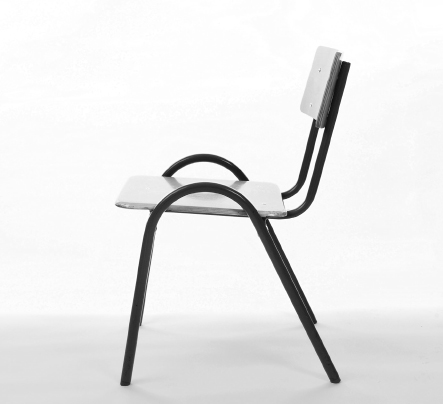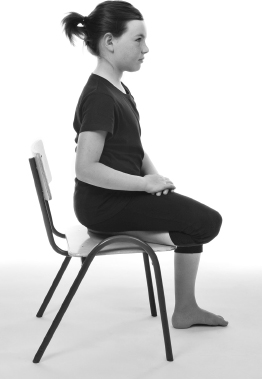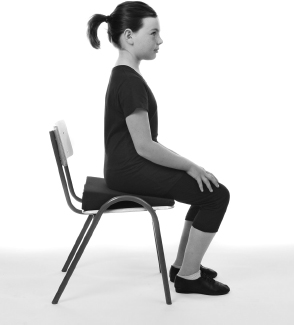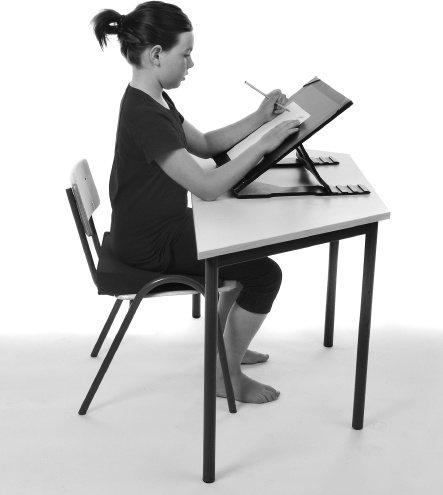
The rise in back problems over the last century correlates directly with the increasing number of hours we spend seated.
Professor Galen Cranz, author of The Chair
While it is true that the Alexander Technique is principally concerned with improving the way we use ourselves by eradicating detrimental habits that affect our posture, I personally think it is also of great benefit to find out how and why many of these habits originated, so that we can avoid the same problems in the future – and what we sit on affects the way we sit. If some of our postural problems are caused or exacerbated by environmental factors that encourage poor posture, it would obviously be beneficial if we can start to change these, as well as ourselves. In my opinion, one of the major external causes of poor posture is badly designed furniture, and by using chairs that are ‘human friendly’ we will stand a much better chance of maintaining good posture.
It is interesting to observe that back pain and neck problems have reached epidemic proportions in all countries where sitting on chairs has become the norm, and chairs and desks are the most common ergonomic factors that encourage poor posture. Many of us spend as much as 75 per cent of our waking lives sitting on chairs: we sit to eat, we sit at the computer and we sit in the car or on a train or bus when travelling to work and in our homes when relaxing. In the USA, they even have drive-through movies, banks, churches, takeaways and supermarkets. It is sometimes hard to know where it is all going to end – perhaps one day there will be drive-through dentists and doctors as well! But the less we stand and walk, the less we like standing and walking: it becomes a vicious circle. In this chapter, we will analyse if what we are sitting on is in harmony with how the body is designed to sit.
Many people do not realize that the chairs they use can actually mould the form of the human body and can so severely affect posture that I often refer to them as ‘weapons of mass destruction’. Driving for long distances in badly designed car seats can practically cripple us, so by the end of the journey we can barely straighten up afterwards. I thought it would be interesting to find out who designs these kind of seats, which are not only uncomfortable but can actually be harmful when used for long periods, and to find out why they are designed in this way. Some years ago I was invited to Middlesex University in the UK to talk about the Alexander Technique to students in their final year of a degree course in furniture design. Before I began my lecture, I asked the students what is the first thing that they think about before they design a chair. Nearly all of them gave me the same answer: ‘Colour!’ I was a little surprised because I had expected them to be thinking of something more technical like the height or how the chair supported the human frame. I was intrigued by their answer and wanted to know more. ‘Why colour?’ I asked them. ‘It’s obvious’, they said. ‘If you designed the best chair in the world, but covered it with lime green material, nobody would buy it.’ And then it dawned on me that most furniture designers are putting a great deal of emphasis on whether the chair looks aesthetically pleasing but are paying little attention to designing for the human being who is going to use the furniture. A chair that has lots of inviting curves may initially feel comfortable as we sink into it, but the same chair may offer inadequate support and in the long term put unnecessary strains and stresses on the body.
Let’s analyse the process that young children typically go through when they start to sit for longer and longer periods, to see if there is something to be learnt from it. While at school, most of us sit for over 15,000 hours, which is a huge amount of time, especially if the chair design is putting unnecessary strain on the muscles and joints. It is simply not natural to sit for prolonged periods, no matter how good the chair is, because as we have already mentioned, the body is primarily designed for movement rather than keeping still.
As soon as children go to school at the age of four or five, they are forced to sit in a chair – they have no choice. The teacher, who often has around 30 children to cope with, cannot keep his or her eye on all the children if they are moving freely around the classroom. Since the teacher’s main responsibility is for the safety of all these children, he or she will usually insist that they remain in their chairs for most of the day. The children do not like sitting down for very long, as they find the chair itself is very uncomfortable and is not suited to their natural posture. The main reason for the discomfort is that the horizontal part of the chair, which takes most of the weight of the body, is sloping backwards. Most school chairs are designed in this way because it allows them to be stacked without the danger of falling over, and while that may be more convenient for the cleaners, it is a disaster for the children’s natural upright posture.

21: School chairs are nearly always designed so that the base is backward sloping. This causes children to make a huge effort just to reach their school work, and they have to bend their spines in the process. Many departments of education in various countries require chairs to be sloping backwards to make them stackable.
When children sit on this kind of backward-sloping furniture, which is the norm in many schools, they have no option but to tense many of their muscles in order to maintain an upright posture. I believe that this tension represents the beginning of the numerous musculoskeletal and respiratory problems that we see in our culture today. The children feel uncomfortable, and within minutes they will try to get up and move around the classroom. In most cases, they are immediately instructed to sit down again.
Children have a natural ingenuity and intelligence when it comes to posture and body awareness, and so their next instinctive strategy is to try to counteract the ‘falling backwards’ movement produced by the chair by tilting themselves forwards, raising the back legs of the chair off the floor as they do this. This is an intelligent strategy because it corrects the backward slope of the chair seat, making it level or slightly forward-sloping, and this helps the children to maintain an aligned, upright posture with much less effort. Instead of being curious as to why so many children are tilting their chairs forwards, however, we just tell them exactly what we were told ourselves: ‘Don’t tip the chairs – you will break them!’ Of course, the teacher is mindful of the danger that someone could trip over the back legs, or that the children might tilt too far, fall forward and hurt themselves, but it is interesting to note that it is usually the possible damage to the chair that is given as the reason to stop a child from doing this. The damage to the child’s posture is not even considered or noticed at any stage.
The children still do not give up; they then often develop other techniques to counter the effects of the backward slope, such as sitting on a foot, which also has the effect of raising the pelvis. This is just another way of enabling them to pivot on the sitting bones, again keeping an aligned and healthy spine; however, it is often actively discouraged in case the blood flow to the leg is restricted.
Once they have been prevented from doing what comes naturally to them, eventually the children have to give up, and they learn to endure sitting on backward-sloping chairs for literally thousands and thousands of hours while at school. Sooner or later most, if not all, of them, slowly but surely begin to slump as their back muscles become more and more fatigued. To make matters worse, consider that the children also have to bend over their desks for a large proportion of this time in order to read and write. Since it is very difficult for them to use their hip joints efficiently while sitting on backward-sloping chairs, and the pelvis itself is already rotating backwards, the only option left open to them is to bend their upper back and necks forward, often quite severely. Over time this way of sitting becomes a habit, and many teenagers have a very bent posture even when they are not working at a desk, which can cause unnecessary wear and tear on the vertebrae and discs, thus sowing the seeds of future spinal and back problems.
22: At first children alter the angle of the base by tipping the chair forward, which in effect makes the chair into a forward-sloping chair.

23: If children are not allowed to tip the chair forward, they often resort to sitting on one leg, which can affect the blood flow down the leg.
In effect, what we are doing is this: first we ruin children’s posture by making them sit on badly designed furniture and then, in our ignorance, we chastise the children for slumping. It is pure madness! As their posture begins to deteriorate over the years, they are told to ‘sit up straight’ and ‘put your shoulders back’, but the only way to do this is to over-arch the lumbar spine and contract many of the powerful back muscles, which are already tense. Worse still, the children then begin to think that this is the way they ought to sit. Unfortunately, this rigid posture becomes fixed within the body and can often remain with them for the rest of their days, causing their muscles and joints to become progressively stiffer or more painful as time goes on. It really is a catalogue of disasters, but fortunately for us the solution to this problem is a simple one.
Before we can start to improve sitting, we need to understand a little about the design of the human frame. The bones that we sit on are often referred to as the ‘sitting bones’ (or ischial tuberosities) but are, in fact, the lowest part of the pelvis. If you look at the image of the pelvis on page 113, you will notice that these bones are rounded, and it is not difficult to see that if you put this obviously rounded surface on the backward-sloping base of a chair, gravity will cause it to rock backwards. (If you place a marble or golf ball on a typical backward-sloping chair or car seat, you will see what I mean.) This backward and downward force is exerted on the sitting bones, yet it is these bones that children need to use in order to pivot themselves forward while reading and writing at a desk. Once they find they are unable to rock forward on the sitting bones (because it is very difficult to rock uphill), they will unconsciously find another way to reach the desk, and this usually involves actually bending their spine, which soon causes a misalignment of the entire spine. This bent back eventually becomes a permanent habit, as can be seen in so many teenagers when they sit, stand and walk – even when there is no need. As you can see on page 91, when a child is sitting on a level base or with a small forward slope, her back is very straight (photo 25), yet the same child distorts her back when sitting on a chair that slopes backwards (photo 24).
“The Alexander Technique makes a real difference to my often tense and busy life. Its thoughtful approach has made me calmer, improved my concentration and given me a clearer sense of my own wellbeing. I am grateful for it.”
Joan Bakewell, journalist, writer and TV presenter
24: Even without bending over their desks, children become slumped when sitting on backward slopng furniture… and so do adults.

25: Adding a firm wedge-shaped cushion to a backward-sloping chair can dramatically help to maintain good posture and beneficial breathing habits.
Since many of us have been through this same process in our own childhood, it is hardly surprising that there are millions of people at this very moment suffering with lower back pain. I am personally convinced that school furniture and the tense postures we were told to hold as children have contributed directly to the phenomenal rise in back and neck pain in recent years. This has been backed up by a detailed report by the National Back Pain Association UK, published in October 2005, which stated:
Sustained poor posture, which is probably the key environmental cause of back pain in children and adolescents, results from a combination of factors, the most significant of these seems to be the inappropriate furniture at school.
Elizabeth Langford sums up the situation very well in her book, Mind and Muscle, when she writes: ‘No amount of “physical education” will undo the damage done to schoolchildren condemned to spend hours of every day sitting on such chairs. Good chairs can never guarantee good sitting, but it is scandalous that children, forced to use chairs on which it is impossible to sit properly, are thus moulded for a future of poor co-ordination, back pain, and other health problems.’
When we use a chair whose base slopes backwards, we are actively encouraged to lean backwards and seek support from the back of the chair. This initiates a backward and downward force. The heavier we are, or the greater degree of habitual muscular tension there is in the body, the greater that force will be. The downward force pushes the base of the pelvis forward and eventually we find ourselves sitting with our weight behind the tailbone rather than on the sitting bones, which have been tilted backwards. This, in turn, encourages the spine to adopt a ‘C’shaped slouch, causing compression in the lungs and other internal organs and strain on the ribs and diaphragm and all the intervertebral discs in the lumbar spine. After a short time, we find this position uncomfortable, so we try to sit up straight by over-arching the lumbar area. Soon we find this position tiring and again seek support from the back of the chair and the whole cycle starts all over again.
These days the problem can start even earlier than school, because now most children’s pushchairs and car seats are also following this trend and sloping backwards. In fact, the base of nearly every car seat, chair and sofa slopes backwards, and nowadays some even have the added problem of a firm ‘lumbar support’ pushing into the lower back at the same time. It is hardly surprising that many people have acute back pain after a long drive or when sitting in such a chair for a long time.
As has been thoroughly established by now, back pain is a serious problem in our society today. However, fortunately the solution for correcting chairs is very simple. To solve the problem, all you need to do is alter the base of the chair so it is no longer sloping backwards. This can easily be achieved by using a wedge-shaped cushion. You can also achieve the same effect by taking two books, about 5cm (2in) thick (old telephone books are ideal), and placing one under each of the back legs of the chair. This will make the base of the chair flat or sloping slightly forwards, which will encourage you to pivot on your sitting bones when leaning forwards. Obviously the books are not practical for everyday use, but the wedges can be obtained from most back shops. Make sure that the wedge you buy is made from good quality hard foam. Those made from softer foam may be cheaper, but they are much less effective.
26: If children already have poor posture, it is not enough to rectify the furniture. They will need to have some Alexander lessons to unlearn their bad postural habits.
It is important to use the wedge-shaped cushion for only one hour on the first day and then gradually build up the amount of time you spend sitting on it. This allows time for your muscles to get used to a new and improved way of sitting. After about three to four weeks, you will be able to sit on the cushion comfortably for as long as you like. It is also important to get up and move at least once an hour, because even with the cushion long periods of sitting, on even the best chairs, can still be detrimental. Even better, if you buy a chair that is fully adjustable, you can adjust the angle of the base so you can have it in different positions to suit the task you are doing. Details of websites where you can get good-quality wedges and adjustable chairs can be found on page 179. It is important to note that wedges and forward-sloping chairs are to be used only while you are sitting in activity and not particularly when you are resting. The times when it is most helpful to use the wedge cushion is when you need to lean forward for some reason, such as when writing, working at a computer, eating a meal or driving.
Another important factor when considering the design of chairs is height. It is often the case that the height of a chair is virtually the same for all chairs, yet human beings are very different in size. According to the Guinness World Records, the tallest person in the world is 2.46m (8ft 1in), while the shortest is 0.7m (2ft 5in), so it is also very important that your chair is the correct height for you. A rough rule of thumb is that your chair needs to be a third of your height.
Desks
Desks can be a problem, too. Most desks are also designed to a standard height, so for many people the desk can be too high while for others the same desk can be too low. This can be very problematic during school years, when children are growing at different rates. Your desk should be roughly half your height, but if you change the height of your desk or chair, do allow a little time to get used to the new way of working.
In the past, many school desks used to slope forwards (i.e. they were higher at the back than at the front), like many of the writing desks that you can still buy today, but in recent times most desks have become flat. Writing at a flat desk is harder work because the person has to bend further to write, and this causes more strain. So, with the combination of backward-sloping chairs and flat desks, we now have to bend our spines forwards far more than ever before. Once again, though, the solution is easy, as you can buy or make a small sloping writing platform to put on the desk. If the surface that you are writing on is sloping towards you and the chair is also sloping forwards (as in photo 28), you will find that the angle you have to bend is greatly reduced and therefore will put much less pressure on the muscles, bones and joints. It may well save you a lot of time and trouble if you get an Alexander teacher to show you how to achieve the optimum posture while sitting in this new way rather than trying to work it out on your own.
27: Children contort their bodies in reaction to badly designed classroom furniture – a familiar scene in a great many classrooms today.
If you are one of those millions of people who spend many hours a day working at a desk, you will find these small, simple changes invaluable in helping you to maintain a healthy posture once you have changed your detrimental habits. So, if we apply the Alexander Technique to change the way we use ourselves, and at the same time we alter our chairs and desks to suit us better, this combined strategy can be very empowering for those whose physical pain is exacerbated by prolonged sitting.

28: With a wedge-shaped cushion, a writing platform and some Alexander lessons, this child is sitting quite differently than in photo 27. Her poise, grace of movement and even her overall behaviour can be transformed.
29: Even after our school years, the postural habits prevail as we continue to sit in our habitual way. Without awareness of these habits they often become more and more ingrained as we become older.
30: By using a wedge cushion and having some Alexander lessons, we can relearn how to sit, stand and move with an overall improved use of ourselves. Raising the computer screen may also encourage an upright posture.